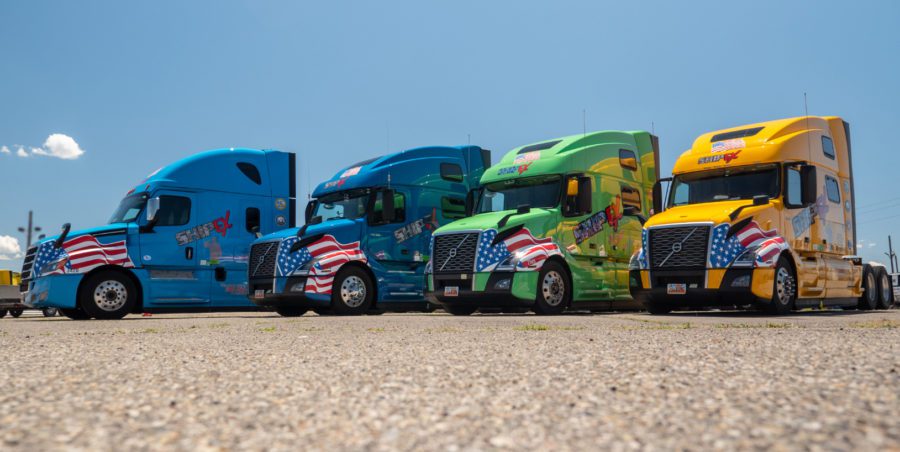OTR means over-the-road, meaning shipments across state lines and sometimes across different countries. Typically, when OTR is used in the trucking industry, it refers to truck drivers hauling all types of freight for long distances. They don’t have dedicated routes and aren’t confined to a regional area.
An OTR truck driver could spend about three or more weeks on the road on a single trip which means they live and work from their truck. They constantly move, going from one pickup and delivery to the next.
Team drivers are needed for certain freight commodities, meaning that two truck drivers are in the cab. They alternate driving so they don’t have to shut down often due to the FMSCA regulations. Team drivers arrive faster to a destination than a solo OTR driver would.
” There are approximately 3.6 million professional truck drivers in the United States, according to the American Trucking Associations (ATA). Of these drivers, the U.S. Bureau of Labor Statistics (BLS) states that more than 2 million drive heavy trucks and tractor-trailers, and more than 1.5 million are delivery drivers or driver/sales workers.”
OTR Compared to Other Types of Trucking
Freight hauled across the country is similar to freight hauled at a local and regional level. However, there are some significant differences between over-the-road, regional, and local. Some of those differences include distance, equipment, lifestyle, & pay.
Local Trucking
Local routes are typically done within a 200-mile radius. Local drivers are only working 8-10 hour days and come home every night. Depending on what trucking company you work for, you’ll also be required to off-load the truck yourself.
You’ll need at least a year of professional driving experience to get hired as a local driver. Local drivers must navigate smaller roads regularly, back into tighter loading docks multiple times a day, and remember optimal routes to avoid high-traffic areas.
Regional Trucking
Similar to OTR trucking, Regional drivers are on the road multiple days at a time and sleep in the sleeper cab of their truck. Regional routes are typically within a 1,000-mile radius and are broken up into divisions, such as the northeast, midwest, etc.
Regional trucking routes often match the average workweek, meaning some truckers can be home on the weekends.
Dedicated Routes
When a driver hauls freight for one specific customer on the same route and picks up or delivers it to the same facilities each time, it’s called a dedicated route.
Pros of dedicated routes
- Consistency
- Helps build relationships
- Consistent pay
- long-term agreements
Cons of Dedicated Routes
- Lack variety
- Less than ideal routes
- Higher chance of burnout
Regional vs. OTR
The most significant difference between regional and OTR trucking is that drivers who choose to do Regional typically stay within one region to avoid entering other areas of the country.
Another significant difference between Regional trucking and OTR trucking is the amount of home time. Since Regional routes only cover certain parts of the country, they don’t cover as much ground. Their trips are much shorter than OTR truck drivers, and they get home more often.
Most Important skills for an OTR Truck Driver
OTR Driving is not for everyone. OTR truck drivers need a unique skill set to be successful on the road.
Driving Skills
You must pass your CDLtrain ing and obtain your commercial driver’s license at a truck driving school to become a truck driver. You learn all the tools and driving skills to teach you to be the safest driver possible. Some companies will even require a clean driving record for their hiring requirements.
OTR drivers must have different driving skills than a “4-wheeler” driver or even a local driver. They are more focused on safe long-distance driving and freight management than on the tight-space driving local drivers do.
Mechanical Skills
Emergency Roadside Services and local mechanics help you when your truck breaks down. However, there may be times when they aren’t available. You always have to be prepared for instances where these situations occur.
The ability to troubleshoot and understand how to fix possible issues is a tremendous skill for over-the-road trucking.
Time Management
Trucking, especially OTR, is very self-directed, and time management is critical. You don’t have a manager near you monitoring your every move, so you need to make sure you’re on schedule and making good time with your miles so you can pick up and deliver on time.
Trip planning is a massive key to success for over-the-road trucking. This is where drivers will plan their trips and determine where they will stop for the day, at what time, etc. If you get off schedule with lousy time management, it can throw your whole plan off.
OTR Truck Driver Salary
Truck drivers’ salary for over-the-road trucking is never the same for two people. This has a lot to do with the fact that most companies within the trucking industry pay drivers cents per mile (CPM), which isn’t always consistent.
A Day In the Life of an OTR Trucker

Your days will likely not be the same as an OTR truck driver, as you’re constantly driving through state lines, picking up and delivering loads at different times, etc.
Let’s look at what you can expect during your day as an OTR driver.
Morning Routine
Typically truck drivers start their day early. They must keep to a schedule if they want to make their pickup or delivery on time.
They also need to find suitable parking. Truck stop parking is limited and usually fills up early in the day. If drivers start their day early, they’ll be able to end their day earlier, which increases the chance of finding available parking for the night.
An OTR truck driver’s morning routine is typically quick because drivers want a head start on their day. Typically, they’ll grab a shower at the truck stop, pick up or make a quick breakfast, and conduct a thorough pre-trip inspection to ensure nothing is wrong with their truck or trailer. Then, they’re on their way!
Throughout the Day
Drivers usually eat their meals at restaurants or cook with essential ingredients in a crock-pot or microwave. It is important to eat something quick because driving jobs require an 11-hour driving limit with a 30-minute break.
You can keep in contact with family through phone calls on the road. Make sure to be careful not to be too distracted while driving!
End of Day
Parking can be difficult, especially at the end of the day. Truck drivers try to plan so they can get a good parking spot for the night.
Most drivers sleep in trucks on beds, but some sleep at truck stops during lousy weather. Make sure you get at least 10 hour rest period at the end of the day.
When drivers stop for the night, it’s essential to keep up with hobbies, maintain relationships, and get a rest period to help avoid burnout.
How to Become an OTR Truck Driver
The first step to becoming a truck driver is passing your state’s regular driver’s license exam. U.S. driver’s license fees cost between $20 and $90. You also need to complete high school or the GED. In most states, you can earn your GED in around four months for $80 to $140.
Next, it’s time to start a professional training program. Driver training programs may last up to a year.
You also need your CDL. CDLs come with different classifications (A, B, and C), depending on the size and weight of your vehicle. The CDL-A is the most versatile for drivers of large freight.
When you have your CDL, you should look into job placement assistance. Some truck driving schools offer job boards and career counseling.
Finally, you need to complete your training. Most companies require newly licensed employees to complete an in-house training program. The program itself may last three to four weeks and involve a period of supervised driving.
Step 1: Keep State Drivers Licence up to Date
Keeping your regular driver’s license to get CDL is essential. Some delivery truck jobs only require a driver’s license, depending on vehicle size.
Step 2: Finish High School/GED
Not all jobs require Diploma, but long-haul trucking jobs do. Even though classes may seem unrelated, they teach valuable skills like time management.
Step 3: Begin Professional Training to Earn CDL
There are many sources of professional training, private driving schools, community college, and training programs through trucking companies. Make sure to learn your state’s requirements for accrediting. Costs range from free to $10,000, some options for financial aid, and acquiring the appropriate CDL test. You can use the job requirements section for CDL classes.
- Class A CDL (most common): Required to operate vehicles with a gross combination weight rating of 26,001 pounds or more (tractor-trailers, tankers, livestock carriers, and flatbeds).
- Class B CDL: Required to operate a single vehicle that isn’t hitched to a trailer with a combined weight greater than 26,001 pounds (tourist busses, school buses, heavy delivery trucks).
- Class C: Required to operate a single vehicle with a combined weight greater than 26,001 pounds or a vehicle towing another vehicle that weighs less than 10,000 pounds (double trailers, tank trucks, and HAZMAT vehicles).
Step 4: Find the Perfect OTR Trucking Job
You need to search for truck driving jobs that fit your needs to find the perfect fit for you! While most trucking companies pay CPM, we pay a true base salary of $62,500 yearly at ShipEX. Weekly pay is approximately $1201.
Since this is a salary position, this weekly pay will not waiver, even if you are shut down due to weather, mechanical breakdown, or any other industry-related delay.
We also do have opportunities to make more than just the base through our monthly bonuses!
Consider finding the perfect OTR trucking job with us!



